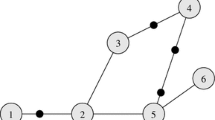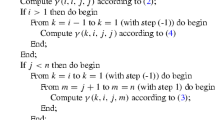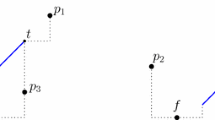Abstract
Location of new stations/stops in public transportation networks has attracted much interest from both the point of views of theory and applications. In this paper we consider a set of pairs of points in the plane demanding traveling between the elements of each pair, and a tree network embedded in the plane representing the transportation system. An alternative mode of transportation competes with the combined plane-network mode so that the modal choice is made by distance (time) comparisons. The aim of the problem dealt with in this paper is to locate a new station/stop so that the traffic through the network would be maximized. Since stops at new stations increases the time of passengers that already used the combined mode, and may persuade them to change the mode, a constraint on the increase of the overall time is imposed. A quadratic in the number of pairs time algorithm is proposed.






Similar content being viewed by others
References
Boyd, S. P., & Vanderberghe, L. (2004). Convex optimization. Cambridge: Cambridge University Press.
Carrizosa, E., Harbering, J., & Schöbel, A. (2016). Minimizing the passengers’ traveling time in the stop location problem. Journal of the Operational Research Society, 67, 1325–1337.
Cascetta, E. (2009). Transportation system analysis. New York: Springer.
Dearing, P. M., Francis, R. L., & Lowe, T. J. (1976). Convex location problems on tree networks. Operations Research, 24, 628–642.
Gendreau, M., Laporte, G., & Mesa, J. A. (1995). Locating rapid transit lines. Journal of Advanced Transportation, 29, 145–162.
Hamacher, H. W., Liebers, A., Schöbel, A., Wagner, D., & Wagner, F. (2001). Locating new stops in a railway network. Electronic Notes in Theoretical Computer Science, 50, 1–11.
Körner, M.-C., Mesa, J. A., Perea, F., Schöbel, A., & Scholz, D. (2014). A Maximum trip covering location problem with alternative mode of transportation on tree networks and segments. TOP, 22, 227–253.
Kranakis, E., Penna, P., Schlude, K., Taylor, D. S., & Widmayer, P. (2003). Improving customers proximity to railway station. LNCS, 2653, 264–276.
Laporte, G., & Mesa, J. A. (2020). The design of rapid transit networks. In G. Laporte, S. Nickel & F. Saldanha-da-Gama (Eds.), “Location Science” 2nd Edition, Chapter 24 (pp. 685–702). Berlin-Heidelberg: Springer.
Laporte, G., Mesa, J. A., & Ortega, F. A. (2002). Locating stations on rapid transit lines. Computers & Operations Research, 29, 741–759.
Laporte, G., Mesa, J. A., Ortega, F. A., & Sevillano, I. (2005). Maximizing trip coverage in the location of a single rapid transit alignment. Annals of Operations Research, 136, 49–63.
Laporte, G., Mesa, J. A., & Perea, F. (2014). Adding a new station and a road link to a road–rail network in the presence of modal competition. Transportation Research B, 68, 1–16.
López-de-los-Mozos, M. C., Mesa, J. A., & Schöbel, A. (2017). A general approach for the location of transfer points on a network with a trip criterion and mixed distances. European Journal of Operational Research, 260, 108–121.
Mecke, S., Schöbel, A., & Wagner, D. (2006). The station location problem on two intersecting lines. Electronic Notes in Theoretical Computer Science, 92, 52–64.
Poetantro, D. R., Hamacher, H. W., Horn, S., & Schöbel, A. (2009). Stop location design in public transportation networks: covering and accessibility objectives. TOP, 17(2), 335–346.
Schöbel, A. (2005). Locating stops along bus or railway lines - A bicriteria problem. Annals of Operations Research, 136, 211–227.
Schöbel, A., Hamacher, H., Liebers, A., & Wagner, D. (2009). The continuous stop location problem in public transportation networks. Asia-Pacific Journal of Operational Research, 26, 13–30.
van Nes, R., & Bovy, P. H. L. (2000). Importance of objectives in urban transit-network design. Transportation Research Records: Journal of Transportation Research Board, 1735, 25–34.
Vuchic, V. R., & Newell, G. F. (1968). Rapid transit interstation spacings for minimum travel time. Transportation Science, 2, 303–339.
Acknowledgements
This work was in part supported by Ministerio de Economía y Competitividad (Spain)/FEDER under grant MTM2015-67706-P and by Ministerio de Ciencia e Innovación (Spain)/FEDER under grant PID2019-106205GB-100.
Author information
Authors and Affiliations
Corresponding author
Additional information
Publisher's Note
Springer Nature remains neutral with regard to jurisdictional claims in published maps and institutional affiliations.
Appendix: Proofs of lemmas stated in the main text
Appendix: Proofs of lemmas stated in the main text
1.1 1 Proof of Lemma 6
Proof
Let us consider \((i , j) \in {\overline{C}}\) holding (5), and let x be a given point of edge \({\varvec{e}}\). From Property 2, we have \(h_{ij}^{min}(v_k, v_r) > \tau _{ij} \), \(\forall v_k, v_r \in V_s\). It only remains to prove \(h_{ij}^{min}(x, w) > \tau _{ij}\), for any \(w \in V_s\). From definition of \(h_{ij}^{min}(x, w)\) (see (1)), it is sufficient to prove that \(h_{ij}(x, w) > \tau _{ij}\). Hence, we have
\(\square \)
1.2 2 Proof of Lemma 7
Proof
Let x be a given point of edge \({\varvec{e}}=[u,v]\). Condition (6) can be rewritten as
Let \((i, j) \in {\overline{C}}\) be a pair holding this inequality. From Property 4, for concluding that \((i, j) \in {\overline{C}}(x)\), we need to prove \(P_{ij}(x) = \emptyset \), which is equivalent to prove \(h_{ij}^{min}(v_k, v_r) > \tau _{ij}\), for all \(v_k, v_r \in V_s \cup \{x\}\).
First, \((i, j) \in {\overline{C}}\) implies \( h_{ij}^{min}(v_k, v_r) > \tau _{ij}, \; \forall v_k, v_r \in V_s\). Therefore it remains to prove that \(h_{ij}^{min}(x, w) = \min \{ h_{ij}(x, w), h_{ji}(x, w)\}> \tau _{ij}\), for all \(w \in V_s\). Since the same reasoning applies to both \(h_{ij}(x, w)\) and \(h_{ji}(x, w)\) by interchanging i and j, the proof is completed by showing that \(h_{ij}(x, w) > \tau _{ij}\).
From definition of the \(\alpha _j\)-values, both \(w_j\) and the end vertex (u or v) at which \(\alpha _j\) is reached belong to the same subtree, and it occurs the same with \(w_i\) and \(\alpha _i\). Hence, we have
\(\square \)
1.3 3 Proof of Lemma 22
Proof
The first statement of the lemma is the trivial case, and for the second one we note that Corollary 11 implies \(C^{+}(x_k)=C_{cand}({{\varvec{e}}}; \uparrow ) \cap C(x_k)\), and \(C^{-}(x_k)=C_{cand}({{\varvec{e}}}; \downarrow ) \cap {\overline{C}}(x_k)\). Therefore the given characterization of \(C^{+}(x_k)\) follows straightforward from Corollary 18 and definition of sets \(L(x_k)\), (here we note that \(L(x_k)\), \(x_k \in Q({\varvec{e}})\), are the sets introduced in the proof of Theorem 19).
We next discuss in more detail \( C^{-}(x_k)\). Let \((i, j) \in C_{cand}({{\varvec{e}}}; \downarrow )\) be a given pair. Thus, we analyze the conditions so that \((i, j) \in {\overline{C}}(x_k)\). First, \((i, j) \in {\overline{C}}(x_k)\) requires \(x_k \in P(v_k, v_r)\), for all \(P(v_k, v_r) \in P_{ij}\), otherwise from Lemma 8, \((i, j) \in C(x_k)\). And, from Corollary 18, \((i, j) \in {\overline{C}}(x_k)\) also requires \((i, j) \notin L(x_k)\) and \(h_{ij}^{min}+\delta _{x_k} > \tau _{ij}\). This concludes the proof. \(\square \)
1.4 4 Proof of Lemma 23
Proof
For \(k = 1, \ldots , \ell -1\), each set \(L_{ini}(x_k)\) contains the pairs such that some associated sublevel set has an endpoint at \(x_k\). Thus, in passing through \(k = 1, \ldots , \ell -1\), the sets \(L(x_k)\) are updated by incorporating the pairs \((i, j) \in L(x_{k-1})\) with some sublevel curve defined at \(x_k\), which means \(x_k \in S_{ij}\). As consequence, from \(L(x_k)\) both \(C^{+}(x_k)\) and \(C^{-}(x_k)\) can also be computed according with Lemma 22. Finally, for the case \(C^{-}(x_k)\), condition \(x_k \in P_{ij}(v_k, v_r)\) is equivalent to \({\varvec{e}} \subseteq P_{ij}(v_k, v_r)\) when \(k = 1, \ldots , \ell -1\). \(\square \)
Rights and permissions
About this article
Cite this article
López-de-los-Mozos, M.C., Mesa, J.A. To stop or not to stop: a time-constrained trip covering location problem on a tree network. Ann Oper Res 316, 1039–1061 (2022). https://doi.org/10.1007/s10479-021-03981-w
Accepted:
Published:
Issue Date:
DOI: https://doi.org/10.1007/s10479-021-03981-w




